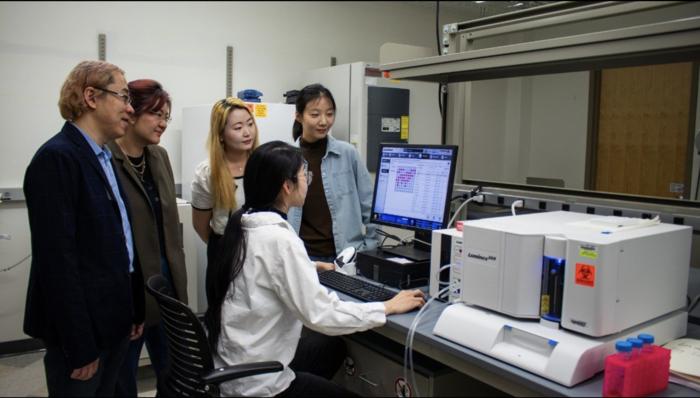The team of scientists proposed a sequence of transformations starting from a chemical compound — a triphenylene molecule — to graphene nanoparticles, soot, and carbon dust, which are building materials for a considerable part of meteorites

Credit: Samara University
The international team of scientists proposed a sequence of transformations starting from a chemical compound — a triphenylene molecule — to graphene nanoparticles, soot, and carbon dust, which are building materials for a considerable part of meteorites.
The team of scientists of Samara National Research University, Florida International University, the University of Hawaii and Lawrence National Laboratory (Berkeley) proposed and during the experiment confirmed the formation mechanisms of the primary building block for a part of meteorites and planets – triphenylene molecules. The results of the study are published in the article “Gas-Phase Synthesis of Triphenylene (C18H12)” and placed on the cover of the high ranking journal ChemPhysChem.
Triphenylene is a key element around which larger graphene-like structures are formed, which then gradually “stick together” into layered nanoparticles. The latter, colliding with each other, are combined into particles of soot and carbon dust. Due to gravity, dust is collected in the simplest meteorites – carbonaceous chondrites, and then in other, larger celestial bodies, including planets.
The formation mechanism of triphenylene was confirmed by quantum-mechanical calculations carried out by a team of Samara University scientists from the research laboratory “Physics and Chemistry of Combustion”, supported by the megagrant of the Russian government “Developments of Physically Grounded Combustion Models” (grant No. 14.Y26.31.0020). The aim of the research is to study the formation mechanisms of harmful substances in combustion chambers, which include polyaromatic hydrocarbons (PAHs), nanoparticles and soot.
“In fact, we have found one of the starting mechanisms for reactions that trigger the formation of nanoparticles, soot and carbon dust both in the combustion chambers of engines and in the molecular clouds of the galaxies,” – said Head of Samara University Physics and Chemistry of Combustion Laboratory, Professor of Florida International University Alexander Mebel.
The calculations showed that the process of triphenylene formation can proceed not only in flames at high temperatures, but also in conditions of extra-low temperatures in interstellar space, triggering the growth mechanism of flat polycyclic aromatic hydrocarbons (PAHs) up to nanoscale particles.
In addition, as it is shown by the analysis carbonaceous chondrides having flown to the Earth from space, their composition contains the entire spectrum of particles, ranging from simple PAHs to graphene nanoparticles.
“Our work aroused wide interest of the scientific community not only because we found the mechanism of formation of the triphenylene molecule, but we also determined all the kinetic constants of the processes involved in this reaction”, – added Alexander Mebel. For this reason, the data obtained during the study, according to the Professor of Florida International University, will be in demand both by design engineers for creating environmentally friendly combustion chambers of aircraft and automobile engines operating on hydrocarbon fuels, and by scientists who are studying the formation of various galactic macrostructures from molecular clouds.
###
For reference:
Triphenylene (C18H12) is a polycyclic aromatic hydrocarbon consisting of four benzene rings. Within the study, an international team of scientists showed how a more complex compound of molecules- triphenylene is born in the reaction of the phenanthrenyl radical with vinyl acetylene.
ChemPhysChem is one of the leading interdisciplinary journals in Physical Chemistry and Chemical Physics. According to the Scimago Journal Rank, the journal has the highest quartile Q1 in all scientific areas defined in the database: Chemistry, Physics and Astronomy. According to the Journal Citation Reports, in 2017, the impact factor of the journal was 2.947.
Samara National Research University is a Russian educational and research centre in the field of aerospace technology. It is one of the leading Russian universities, the corresponding status of which is enshrined in the regulatory documents of the Russian Federation Government and recognized by the academic community. Samara University is one of 29 national research universities in Russia. Since 2013, the university has been participating in the programme which is to improve the competitiveness of Russian universities among the world’s leading research and education centers (Project 5-100). Scientific and education activity of Samara University encompasses aerospace technology, engine-building, modern methods of information processing, photonics, materials science, as well as the fundamental technical and natural sciences. In addition to engineering, the university implements educational and research programmes in other areas, including law, economics, management, linguistics, historical and social sciences.
Media Contact
Olga Bukhner
[email protected]
Original Source
https:/
Related Journal Article
http://dx.





